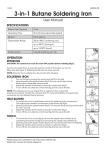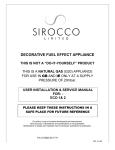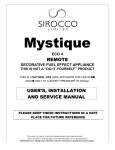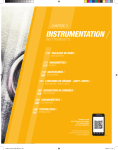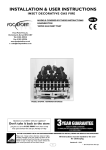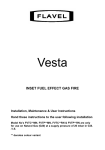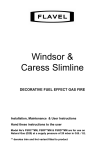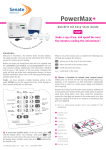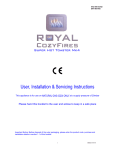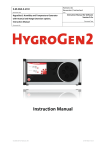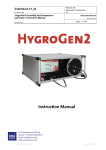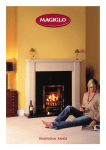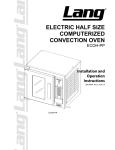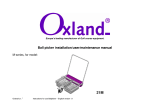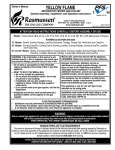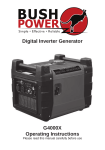Download THIS IS A NATURAL GAS (G20)
Transcript
DECORATIVE FUEL EFFECT APPLIANCE THIS IS A NATURAL GAS (G20) APPLIANCE FOR USE IN GB AND IE ONLY AT A SUPPLY PRESSURE OF 20mbar. MODELS 16” AND 18” REMOTE AND MANUAL VERSIONS USER’S, INSTALLATION AND SERVICE MANUAL PLEASE KEEP THESE INSTRUCTIONS IN A SAFE PLACE FOR FUTURE REFERENCE VI-06-09 TABLE OF CONTENTS IMPORTANT NOTES___________________________________________ 3 USER’S SECTION _____________________________________________ 4 FUEL EFFECT ________________________________________________ 4 GAS CONSUMPTION __________________________________________ 4 OPERATING INSTRUCTIONS MANUAL VERSION _______________ 4 TO LIGHT THE FIRE _________________________________________________4 SELECT THE BURNER FLAME LEVEL _________________________________4 TO TURN OFF _______________________________________________________4 CLEANING _________________________________________________________4 OPERATING INSTRUCTIONS REMOTE CONTROL VERSION___________ 5 TO LIGHT THE FIRE _________________________________________________5 TO SELECT THE REQUIRED FLAME LEVEL ____________________________5 TO TURN OFF _______________________________________________________5 OXYGEN DEPLETION SYSTEM __________________________________ 5 FUEL BED ASSEMBLY _________________________________________ 6 INSTALLATION SECTION______________________________________ 16 1 2 3 4 5 6 6.5 6.6 7 8 9 10 10.1 10.2 10.3 11 12 GENERAL DATA_________________________________________ 16 GENERAL INSTALLATION REQUIREMENTS __________________ 16 CHECK CARTON CONTENTS ______________________________ 17 THE FIREPLACE ________________________________________ 17 GAS SUPPLY PIPE_______________________________________ 18 APPLIANCE INSTALLATION _______________________________ 18 CHECK FOR GAS SOUNDNESS ____________________________ 18 FUEL BED ASSEMBLY____________________________________ 18 FUNCTIONAL CHECKS ___________________________________ 18 CHECK FOR SPILLAGE ___________________________________ 19 FINAL CHECK AND CUSTOMER BREIFING ___________________ 19 SERVICING_____________________________________________ 19 TO REMOVE THE BURNER UNIT ___________________________ 20 TO REMOVE THE PILOT BURNER ASSEMBLY ________________ 20 TO REMOVE THE GAS TAP / FSD / IGNITION UNIT ____________ 20 MAINTENANCE SPARES __________________________________ 21 FAULT FINDING _________________________________________ 21 VI-06-09 2 IMPORTANT NOTES 1. SOFT WALL COVERINGS, (e.g. EMBOSSED VINYLS etc.) WHICH HAVE A RAISED PATTERN, ARE EASILY AFFECTED BY HEAT AND MAY SCORCH OR BECOME DISCOLOURED WHEN CLOSE TO A HEATING APPLIANCE. PLEASE BEAR THIS IN MIND WHEN RE-DECORATING. 2. AS WITH ANY GAS FIRE, THIS APPLIANCE MUST BE INSTALLED BY A COMPETENT PERSON (e.g. IN GB A C.O.R.G.I. MEMBER) IN ACCORDANCE WITH THE INSTALLATION INSTRUCTIONS AND THE LATEST EDITION OF THE GAS SAFETY (INSTALLATION AND USE) REGULATIONS OR THE RULES IN FORCE. 3. IF THE FIRE IS INTENDED TO BE INSTALLED TO A FIREPLACE THAT WAS PREVIOUSLY USED FOR BURNING SOLID FUELS THE CHIMNEY MUST BE SWEPT PRIOR TO INSTALLATION. 4. THE FIRE MUST NOT BE INSTALLED DIRECTLY ONTO CARPETS OR OTHER COMBUSTIBLE MATERIALS. 5. THE FIRE MUST STAND ON A NONCOMBUSTIBLE HEARTH. THE HEARTH MATERIAL MUST BE A MINIMUM OF 12.5mm THICK. ITS TOP SURFACE SHOULD BE 50mm ABOVE THE FLOOR LEVEL TO DISCOURAGE THE PLACING OF RUGS, CARPETS O R OTHER COMBUSTIBLE MATERIALS OVER IT. THE FINISHED HEARTH LEVEL MUST EXTEND 300mm BEYOND THE VERTICAL FACE OF THE FIREPLACE OPENING FOR BOTH THE 16” AND 18” MODELS. THE MINIMUM WIDTH OF THE HEARTH MUST BE 650mm FOR THE 16” VERSION AND VERSION. 700mm FOR THE 18" 6. THE FIRE MUST NOT BE FITTED AGAINST A COMBUSTIBLE WALL. 7. THE MINIMUM HEIGHT ABOVE THE TOP SURFACE OF THE HEARTH FOR ANY PROJECTION (e.g. SHELF etc.) 150mm DEEP MADE FROM WOOD OR ANY OTHER COMBUSTIBLE MATERIAL IS 766mm. FOR COMBUSTIBLE PROJECTIONS ABOVE 150mm DEPTH ADD 12.5mm TO THE ABOVE CLEARANCE FOR EVERY 25mm OF ADDITIONAL PROJECTION DEPTH. 8. NEVER THROW PAPER MATERIAL ONTO THE FIRE. 9. IT SHOULD BE APPRECIATED THAT ALTHOUGH THIS APPLIANCE CONFORMS TO ALL THE REQUIRED STANDARDS, IT IS A DECORATIVE FUEL EFFECT HEATING APPLIANCE WITH AN OPEN FLAME AND CERTAIN PARTS OF ITS SURFACE WILL BECOME HOT. A SUITABLE GUARD, WHICH COMPLIES WITH THE REQUIREMENTS OF B.S. 8423 IS THERFORE RECOMMENDED FOR THE PROTECTION OF THE VERY YOUNG, THE ELDERLY OR THE INFIRM. SUCH A GUARD IS ALSO RECOMMENDED FOR THE PROTECTION OF PET ANIMALS. OR OTHER 10. ALWAYS SWITCH THE FIRE OFF AND ALLOW SUFFICIENT TIME FOR IT TO COOL DOWN BEFORE HANDLING ANY COMPONENTS. 11. PLEASE NOTE THAT THIS APPLIANCE RETAINS HEAT FOR A LONG TIME AFTER IT HAS BEEN TURNED OFF. PLEASE NOTE On first lighting your new fire, a slight odour may occur due to its new condition. This is quite normal and will disappear after a few hours use. type. Due to the nature of this kind of burner, there will be various “popping” and flame noises not usually associated with ordinary gas fires. As in a real coal fire, these noises are perfectly normal. After some hours use, the ceramic coal pieces may change colour. This is quite normal. The fire has been designed to give years of trouble free service. To maintain its optimum performance, advantage should be taken of the regular servicing and inspection facilities available for gas appliances. Annual servicing is recommended. These instructions are provided to help you in operating the fire and should be kept in a safe place. Some granules will be lost during the lifetime of the appliance while cleaning etc. to allow for replacement, surplus granules are supplied with your new appliance. Keep these in a safe place. In order to obtain an authentic flame effect, the burner on this appliance is a granular filled pan VI-06-09 3 USER’S SECTION FUEL EFFECT 3. This fire is supplied with ceramic fuel effect pieces to simulate a real fire and a granular bed to provide even flame distribution across the whole of the bed. These items are safe to handle and the coals are designed for easy re-fitting after removal. Release the control knob. The pilot should remain lit independently. SELECT THE BURNER FLAME LEVEL NOTE: When first turned on the flames will appear predominately blue. The coal bed will take time to warm up. Although some glow will be seen after 5 – 10 minutes, the full effect will only be apparent after a somewhat longer time. GAS CONSUMPTION This fire has a maximum gas input of 6.9 kW, which is equal to approximately 4.25 hours use for one therm of natural gas. 1. After lighting the pilot as described above, turn the control knob anti-clockwise to the HIGH position. The fire will now ignite. OPERATING INSTRUCTIONS Manual Version 2. To decrease the amount of flame push the control knob in slightly and turn to the LOW position. The fire can now be used at any desired setting at any position between minimum (LOW) and maximum (HIGH). Figure 1 OFF TO TURN OFF IGNITION 1. Push in and turn the control knob clockwise to the OFF position to extinguish the flames and the pilot flame. 2. If desired he pilot flame can be left on to make it quicker and easier to light the fire. Although the pilot is using gas all the time it is on, the amount used is minimal. To do this turn the control knob to the IGNITION position instead of the OFF position as described above. If the fire is to be switched OFF for long periods, it is recommended that the control knob be turned to the OFF position. HIGH LOW For your safety, the fire is fitted with a Flame Supervision Device (FSD), which will shut off the gas supply if for any reason the pilot is extinguished. This device incorporates a fixed probe, which senses heat from the pilot burner flame. If the probe is cool, the device will prevent any gas flow unless the control knob is pushed in at the IGNITION position. CLEANING All cleaning MUST be carried out when the fire is cold. NOTE: Heat is retained for some time after the fire is switched OFF. Clean the surround and fender parts with a slightly damp cloth and then dry. Abrasive cleaners should NOT be used. If for any reason the flames go out or if the fire has been turned off for any reason, always WAIT FOR 3 MINUTES before attempting to relight. TO LIGHT THE FIRE 1. From the off position, SLOWLY push in and turn the control knob anti-clockwise to activate the spark at the IGNITION position. 2. Keep the control knob pressed in at this position for approximately 10 – 20 seconds to allow the Flame Supervision Device to warm. Normally the fire should only need dusting. Light coatings of soot will usually be burnt off during the normal operation of the fire. If however, particles of mortar from the chimney accumulate these should be removed from the coals and back brick by dismantling them and cleaning with a soft brush. If you remove the fuel effect pieces, then do so in the reverse order to that shown in the fuel bed fitting instructions (pages 9 – 15). 4 VI-06-09 If soot or other foreign matter has become mixed with the granular materials and cannot be removed by hand, remove the contaminated layer and replace with a clean layer from the bag of granules supplied with the fire. When levelling ensure that none of the granules are pushed into the pilot burner outlet. To turn the fire up, point at the sensor, push the plus button until the desired flame height is reached. The fire may be left in the standby mode (pilot only) by pressing the small round button on the handset. If large pieces of debris are found any where in the fireplace, the chimney and appliance should be inspected and serviced by a competent person before further use. TO TURN OFF To turn your fire off, point the handset at the sensor and push the top left button. The fire will go out. OPERATING INSTRUCTIONS Remote Control Version OXYGEN DEPLETION SYSTEM TO LIGHT THE FIRE If the Oxygen Depletion System (ODS) operates, i.e. shuts off the gas supply to the fire, WAIT FOR THREE MINUTES and follow the operating instructions on pages 4 and 5. (Ensure the battery is connected and batteries are also in the handset) To light the fire, point the handset to the sensor on the front your fire. Push and hold the two buttons together, on the left hand side of the handset. The fire will give out a beep sound and you can release the buttons. After a few seconds you will hear the clicking spark to the pilot light. Once the pilot is lit the fire main burner will come on to the high position (this whole process will take no more than 20 seconds). The ODS is designed to shut off the gas supply to the burner if the oxygen content of the room falls below a certain level. If it continues to operate then contact your installer to have the fire and flue system checked. SERVICING AND MAINTENANCE If your fire requires servicing or maintenance, please contact your supplier quoting the model name (Streamline 3) and the serial number. Both of which can be found on the data badge, which is located next to the control knob behind the ash pan cover. BATTERY REPLACEMENT USE ALKALINE BATTERIES ONLY (9 Volt PP3) IN THE HANDSET TO SELECT THE REQUIRED FLAME LEVEL To turn down the fire, point the handset to the sensor on your fire then push and hold the minus button (small flame), if you release immediately the flame will go to low if you hold the flame will lower slowly and you can release the button to your desired position. 5 VI-06-09 FUEL BED ASSEMBLY The Streamline 3 is available with 3 different fuel effects as follows: The granular dispersal compound provided in a plastic bag should be poured into the cast iron tray and gently levelled to within 5mm of the lip of the tray. Remove any spilt granules from under or around the and particularly from the pilot assembly. ALWAYS ENSURE THAT THE GRANULAR MATERIAL LIES LOOSELY AND IS NOT ALLOWED TO COMPRESS. Sprinkle the ember material across the top surface of the granular material. The ember material is in a separate smaller bag. Coal Made up of 25 coals. Turn to page 9 for layout instructions. Pebbles Made up of 25 pebbles. Turn to page 11 for layout instructions. Logs Made up of 13 coals and 7 logs and pinecones. Turn to page 13 for layout instructions. COAL LAYOUT Figure 5 1. Place the two centre ceramic pieces as shown. The angled edge should be in line with the edge of the burner tray casting. NOTE: On the 18” version there should be a gap of approximately 50mm between the centre ceramics. 6 VI-06-09 A Figure 6 2. Place two rows of 4 coals as shown above ensuring that the front coals overhang the edge of the casting at the front and the rear coals are touching the rear wall of the fireplace or convector box. Note: on the 16” version the right hand front coal is a narrow coal different to the rest to allow it to be fitted at the side of the pilot (marked `A’ above). Figure 7 3. Place a row of 5 coals along the top of the centre ceramics as shown above. 7 VI-06-09 Figure 8 4. Place two rows of 3 coals bridging the gaps in the rows beneath as shown above. The rear row of coals should be touching the rear wall of the fireplace or convector box. Figure 9 5. Place another row of 2 coals bridging the gaps in the rear row of coals placed in step 4. Place a row of 4 coals bridging the gaps in the front row of coals placed in step 4. 8 VI-06-09 PEBBLE LAYOUT Figure 10 1. Place the two centre ceramic pieces as shown. The angled edge should be in line with the edge of the burner tray casting. On the 18” version there should be a gap of approximately 50mm between the centre ceramics. A Figure 11 2. Place two rows of 4 pebbles as shown above ensuring that the front pebbles overhang the edge of the casting at the front and the rear pebbles are touching the rear wall of the fireplace or convector box. Note: on the 16” version the right hand front pebble is a narrow pebble different to the rest to allow it to be fitted at the side of the pilot (marked `A’ above). 9 VI-06-09 Figure 12 3. Place a row of 5 pebbles along the top of the centre ceramics as shown above. Then place a further two rows of 3 pebbles bridging the gaps in the rows beneath as shown above. The rear row of pebbles should be touching the rear wall of the fireplace or convector box. Figure 13 4. Place another row of 2 pebbles bridging the gaps in the rear row of pebbles placed in step 3. Place a row of 4 pebbles bridging the gaps in the front row of pebbles placed in step 3. 10 VI-06-09 LOG LAYOUT Figure 14 1. Place the two centre ceramic pieces as shown. The angled edge should be in line with the edge of the burner tray casting. On the 18” version there should be a gap of approximately 50mm between the centre ceramics. A Figure 15 2. Place two rows of 4 coals as shown above ensuring that the front coals overhang the edge of the casting at the front and the rear coals are touching the rear wall of the fireplace or convector box. Note: on the 16” version the right hand front coal is a narrow coal different to the rest to allow it to be fitted at the side of the pilot (marked `A’ above). 11 VI-06-09 Figure 16 3. Place a row of 5 coals along the top of the centre ceramics as shown above. Figure 17 4. Place the first layer of logs as shown above. 12 VI-06-09 Figure 18 5. Place the second layer of logs as shown above. Slight rearrangement of the logs may be required, when it has been established where the flames are burning, to produce the best flame effect. Coal Layout First layer Figure 19 13 VI-06-09 Second layer Figure 20 Third layer Figure 21 14 VI-06-09 Coal Layout First layer Figure 22 Second layer Figure 23 15 VI-06-09 INSTALLATION SECTION Installations in IE The installation must be carried out by a competent person and installed in accordance with the current edition of I.S.813 “Domestic Gas Installations” and the current building regulations. NO COMPONENT IS MANUFACTURED FROM ASBESTOS OR ASBESTOS RELATED PRODUCTS. THE APPLIANCE DATA BADGE IS LOCATED NEXT TO THE CONTROL KNOB. 1 GENERAL DATA Gas Type & category 2.2 NATURAL GAS (G20) I2H Inlet Pressure: Maximum Input Gross: Gas Connection: Pilot Assembly: Gas Tap Assembly: A Fireplace recess built from components according to BS 1251 “Open Fireplace Components”. (see Figure 3). 20mbar 6.9kW 8mm COMPRESSION NG20 9079 NG20 9017 GH-687-004-001 The Minimum depth of the opening (see Figure 3 dimension C) in the case of both the 16” and 18” variants shall be 170MM. The minimum front width (see Figure 3 dimension A) of the chairbrick opening shall be 380mm for the 16” and 430mm for the 18” version. The minimum rear width (see Figure 3 dimension B) shall be 250mm in the case of the 16” and 300mm for the 18” version. The flue should be a Class 1 type with a minimum effective height of 3 metres. The following are used on the Remote Control version only: Solenoid Assembly: Remote Receiver: Remote Handset: Battery Type: BSB22311009 STDSA 2324 STD 2323 9 Volt ALKALINE (PP3) 2 GENERAL INSTALLATION REQUIREMENTS 2.1 In your own interest and that of safety, it is the law that all gas appliances are installed by competent persons in accordance with the Gas Safety (Installation & Use) Regulations 1994 (as amended) or the rules in force. Failure to install appliances correctly could lead to prosecution. The appliance can be used in the following openings: 2.3 Suitable flues and minimum flue sizes are as follows: a) 225mm x 225mm conventional brick built chimney. b) 175mm diameter lined brick or stone flue. c) 200mm diameter factory made insulated flue manufactured to BS 4543. d) 175mm diameter flue pipe (see BS 6461 : part 1 for suitable materials. The Confederation for the Registration of Gas Installers (CORGI) requires its members to work to recognised standards. The installation MUST be in accordance with these instructions, all the relevant pars of the current editions of the following British Standards and the relevant British Standard installation specifications and codes of practice and the Building Regulations issued by the Department of the Environment and the Building Standards (Scotland) (Consolidation) Regulations issued by the Scottish Development Department: BS 5871 : Part 3 BS 5440 : Parts 1 & 2 BS 6891 BS 6461 : Parts 1 & 2 BS 8303 BS 4543 : Part 2 BS 1251 2.4 The flue MUST NOT be used for any other appliance or application. 2.5 Any chimney dampers or restrictors should be removed. If removal is not possible then they MUST be fixed in the open position. 2.6 If the appliance is intended to be installed to a chimney, which was previously used for solid fuels, then the chimney MUST be swept clean prior to installation. 2.7 If the fireplace is of the underfloor draught type then it MUST be sealed to stop any draughts. The appliance MUST be mounted on a noncombustible hearth (Note: conglomerate marble hearths are considered as non- 2.8 16 VI-06-09 3 combustible). The hearth material MUST be at least 12.5mm thick. Its top surface should be 50mm above the floor level to discourage the placing of rugs or carpets over it. The appliance can be fitted to a purpose made proprietary class “O” – 100°C or 150°C surround. 2.9 2.10 CHECK CARTON CONTENTS Check the contents are as follows: In particular the finished hearth level MUST extend 300mm in front of the vertical face of the fireplace for both the 16” and 18” variants. The minimum width of the hearth is 650mm for the 16” and 700mm for the 18” version. THE APPLIANCE MUST NOT STAND ON COMBUSTIBLE MATERIALS OR CARPETS OR BE FITTED TO A COMBUSTIBLE WALL. 1 1 1 1 1 1 1 1 Streamline 3 Burner Unit. Streamline 3 Base Plate. Isolation Elbow with Nut & Olive. Set of fuel effect pieces (see page 6). Pack of Granular Material Ember Kit Pack. Remote Handset (Remote Version Only). Instruction Manual. Remove the contents carefully checking that all the listed parts are present and in good condition. The minimum height above the top surface of the hearth for any projection (e.g. shelf etc.) 150mm deep made from wood or any other combustible material is 766mm. For combustible projections above 150mm depth, add 12.5mm to the above clearance for every 25mm of additional projection depth. 4 THE FIREPLACE 4.1 FIREPLACE SIZE Make sure that the fireplace conforms to the sizes stated in 2.2 of General Installation Requirements (refer to Figure 3). Figure 3 2.11 Please note that soft wall coverings (e.g. embossed vinyl’s etc.) are easily affected by heat. They may, therefore, scorch or become discoloured when close to a heating appliance. Please bear this in mind when installing. 2.12 The appliance MUST NOT be installed in any room which contains a bath or shower or where steam is regularly present. 2.13 An extractor fan MUST NOT be fitted in the same room as the appliance or in any area from which ventilation is taken IF IT IS LIKLEY TO AFFECT T H E SAFE OPERATION OF THE APPLIANCE. If there is a fan in such a locality, note the spillage test requirements detailed on page 16. 2.14 VENTILATION REQUIREMENTS 4.2 For use in GB purpose-built ventilation is not normally required for this appliance. For use in I E ventilation must be in accordance with IS 813. The fireplace opening should be in good order and have a reasonably flat floor level with the hearth. 4.2 After preparing the fireplace, apply a lighted match, paper or smoke match to the chimney opening. Observe the smoke. If there is a definite flow into the opening, continue with the installation. If there is not a definite flow, pre-heat the chimney for a few minutes and re-check. If there is still no definite flow, the chimney may need attention. DO NOT FIT THE APPLIANCE – SEEK EXPERT ADVICE. 2.15 It is essential that all decorative fenders have a minimum open area of 50cm_ to ensure adequate air supply for correct combustion. 17 VI-06-09 5 GAS SUPPLY PIPE expel any foreign matter that might be blown into the valve assembly, injector, or pilot etc. and cause a blockage. A nut and olive is provided for the copper pipe inlet connection. We would recommend that an isolation tap is fitted upstream of the appliance to facilitate easier connection and disconnection. 6.4 Once the gas supply has been connected and purged then the burner assembly can be refitted in the reverse order to removal ensuring that the tabs on the rear of the base plate fit into the slots on the underside of the burner assembly. 6.5 CHECK FOR GAS SOUNDNESS NOTE: The supply pipe must be of rigid durable material. Flexible pipe MUST NOT be used. 6 APPLIANCE INSTALLATION Turn on the gas supply and check for gas soundness with a suitable leak detection fluid (see BS 6891). 6.1 The appliance base plate should be fitted into position first. To do this remove the two screws from the base of the control panel beneath the control knob. Then disconnect the compression nut on the top of the isolation elbow (see Figure 4). The burner assembly can now be lifted off the base plate leaving behind the base plate and the isolation elbow. Place the burner assembly carefully to one side using the packaging to protect any surface from damage. Please check all joints including the pilot assembly. 6.6 FUEL BED ASSEMBLY Please refer to the User’s section for details on assembling the fuel effect components (Page 6). 7 FUNCTIONAL CHECKS Remove the pressure test point sealing screw from the isolation elbow and attach a suitable pressure gauge. 1 Nut Light the pilot and check the correct operation of the burner at all the flame settings. Refer to the Operating instructions on pages 4 and 5. Figure 4. 6.2 Check that the inlet gas pressure is as stated on page 6 when the fire is at its highest setting. 2 Screws Place the base plate into the fireplace opening with the isolation elbow to the front. The rear of the base plate should touch the rear of the fireplace opening. Ensure that it is in the centre of the opening and mark the required screw positions. Note: The base plate has a number of holes in it for screw fixing. It is not necessary to use all of the holes, just the ones that are convenient. 6.3 Once the base plate has been securely fixed, the gas supply can be connected to the isolation elbow. Gas connection is by concealed connection only. Remember to protect the end of the supply pipe when passing through walls, cavities etc, to stop brick dust and debris entering the pipe and causing a blockage. 6.4 HAVE YOU PURGED THE GAS SUPPLY PIPES? This is essential to Once the fire has been lit for 5 minutes turn the gas OFF at the isolating elbow. After a further 3 minutes turn the gas supply ON again, if the gas has stopped flowing, the Flame Supervision Device (FSD) is operating correctly. Always check that the gas has stopped flowing even if you hear the FSD valve close within the 3-minute period. Turn OFF the appliance and the gas supply and refit the pressure test point sealing screw. Turn ON the gas supply and check for leaks around the pressure test point sealing screw with a suitable leak detection fluid. 18 VI-06-09 soot can be removed as described in CLEANING on page 4 of these instructions. 8 CHECK FOR SPILLAGE A SPILLAGE CHECK MUST BE MADE BEFORE THE INSTALLED APPLIANCE IS LEFT WITH THE CUSTOMER. DO THIS TEST WITH ALL THE COALS FITTED AND THE FENDER AND ASHPAN IN PLACE. CARRY OUT THE TEST AS FOLLOWS: 8.1 Close all doors and windows in the room containing the appliance. 8.2 Light the appliance and set to the HIGH setting. 8.3 Leave the appliance ON for 5 minutes then light a smoke match. The match should be inserted 10mm below the top of the opening and be pointed upwards at 45° to the horizontal. 9.3 Advise the customer that any cleaning MUST be carried out when the appliance is cold. 9.4 Advise the customer that some granules will be lost during the life of the appliance due to cleaning etc. and that the surplus granules should be kept in a safe place for replenishment. 9.5 Please explain to the customer the purpose of the Oxygen Depletion System (ODS) and in particular the following: (a) The ODS system operates if the Oxygen level in the room falls below safe levels usually due to interruption of the evacuation of combustion products i.e. a blocked chimney etc. (b) Describe the restart procedures. (c) Point out that on repeated operation of the ODS system seek expert advice. Move the smoke match across the opening. The installation is satisfactory if all the smoke is drawn into the chimney. 8.4 8.5 If all the smoke is not drawn into the chimney, leave the fire alight for a further 10 minutes at the HIGH setting and then repeat the test. If all the smoke is still not drawn into the chimney, inspect the sealing to the fireplace surround. If the sealing is satisfactory DISCONNECT THE APPLIANCE AND SEEK EXPERT ADVICE. Open all internal connecting doors, hatches, etc in the same room as the appliance. Keep all the doors and windows that open to the outside of the building closed. Re-check for spillage as described above. If an extractor fan is fitted in the same room as the appliance or a connecting room, check that spillage does not occur with the fan operating, all doors, and other openings between the fan and the appliance open. 9 FINAL CHECK AND CUSTOMER BREIFING 9.1 Instruct the customer on the full operation of the appliance. 9.2 Advise the customer how to assemble the fuel effect as described in these instructions and that any build up of 9.6 (Remote Control Version Only) Instruct the customer how to change the batteries in the remote handset and in the remote receiver. USE ALKALINE BATTERIES ONLY 9.7 Hand over these instructions to the customer for keeping in a safe place. 9.8 Recommend that the appliance and chimney should be inspected and serviced by a competent person annually. 10 SERVICING TURN OFF THE GAS SUPPLY AND ALLOW TO COOL BEFORE COMMENCING ANY SERVICING. ALWAYS TEST FOR GAS SOUNDNESS AND SPILLAGE AFTER REFITTING THE APPLIANCE. (A LONG BRUSH MAY BE REQUIRED TO REACH SOME JOINTS FOR SOUNDNESS TESTING.) 19 VI-06-09 Check that the appliance is clean and that soot deposits or debris is not blocking the gaps between coals causing an imperfect flame appearance or that stray pieces of granules are not impairing the electrode spark or pilot burner. For removing the pilot burner, refer to section 10.2. (f) If defective, the whole assembly MUST be replaced. DO NOT attempt to replace the individual components as this could compromise the operation of the ODS pilot. (g) Reassemble in the reverse order. After servicing, make sure that the granules and fuel effect are correctly assembled as described on page 9 – 15. 10.1 Figure 19 TO REMOVE THE BURNER UNIT (a) Remove the fender and ash pan cover together with all the coals. Aeration Hole (b) Disconnect the appliance from the gas-isolating elbow and remove the two screws (refer to Figure 4.). The burner tray can now be lifted up and away from the base plate. Take care to protect the pilot head from damage. NOTE: The burner tray is quite heavy. 2 Screws (c) Tip the granular material into a secure bag. We would recommend the replacement of this inexpensive material and the ember kit. 10.3 (d) Re-assemble in the reverse order. 10.2 TO REMOVE THE GAS TAP / FSD / IGNITION UNIT (a) Follow 10.1 above to remove the burner tray. TO REMOVE THE PILOT BURNER ASSEMBLY (a) Follow 10.1 above to remove the burner tray. (b) Disconnect the thermocouple from the tap. (b) Disconnect the thermocouple connection from the back of the gas valve. (c) Disconnect the 4mm pilot burner tube from the tap. (d) Disconnect the 8mm burner supply tube from the tap (e) Disconnect the 8mm gas inlet tube from the tap. (c) Disconnect the 4mm pilot burner tube from the pilot burner assembly. (d) Disconnect the electrode lead from the pilot burner assembly. (f) Pull off the control knob. (g) Remove the retaining nut from the front of the control panel. The tap / FSD / ignition unit can now be removed and exchanged. (e) Remove the two screws at the front of the pilot burner bracket (refer to Figure 19). The left hand screw need not be removed completely as the pilot burner has a slot in it. (h) Re-assemble in the reverse order. 20 VI-06-09 11 MAINTENANCE SPARES During servicing and maintenance your appliance may need some replacement parts. Here is a short list of spare parts that are available: Supplier Ref. V4-28 P4-10 K1-32 Description Coals Kit Pebbles Kit Logs Kit Granule Kit Ember Kit Gas Tap GH-687-004-001 Co-pilot NG20/H/320/M8/A Remote Battery Pack Remote Handset Control Knob Manufacturers Part No. 1097-1 1098-1 1087-1 1091-1 1096-1 Please contact SIROCCO if other parts are required. 12 FAULT Pilot will not light. No spark. Pilot will not stay lit or fire goes out in use. Uneven flame pattern e.g. flame at one side only. Blue flames. Low flame height. Popping noises. FAULT FINDING CAUSE / POSSIBLE REMEDY See Ignition Functional Check 1. See Ignition Functional Check 2. See Flame Failure Functional Check. 1. The fuel effect may need adjusting to even the flame pattern. See pages 9 – 15. 1. The fire will burn blue on initial lighting, until sufficient heat is generated causing the flames to burn yellow. Typically 10 – 20 minutes. 2. Insufficient gas pressure. Check the supply pressure to the appliance. 3. The primary aeration may be obstructed by dirt, lint, etc. Clean and recheck. 1. Insufficient gas pressure. Check the supply pressure to the appliance. 2. The visual effect is controlled by the placement of the fuel effect pieces. Try slight adjustments. See pages 9 – 15. 1. Some popping noises will always be present. Severe popping may be caused by incorrect gas pressure. Check the supply pressure to the appliance. 2. Incorrect amount of granular material in the burner tray. See section 6.6 on page 8. 3. Try slight adjustments to the fuel effect pieces. See pages 9 – 15. 21 VI-06-09 IGNITION FUNCTIONAL CHECK 1 PILOT WILL NOT LIGHT Ensure there is no debris around the pilot assembly, e.g. coal, soot, etc. which could short the spark, clean the area. Check for fluff in the pilot aeration hole (see Figure 19). Operate the valve. Is there a spark? NO See NO SPARK chart. YES Does the pilot light? NO Is the control being operated correctly? YES SYSTEM OK NO Consult the User's section in this manual and retry. Yes Will the pilot light with a match? NO Is the gas supply turned on to the appliance? NO Check isolation tap and gas meter and retry. YES Ensure the gap between electrode and pilot burner is as Figure 19. If still not working replace ignition lead and then peizo. YES Is the gas pressure correct? NO Correct and retry. YES Has the system got any air in it? NO Ther is a blockage in the system. Check the inlet test point, the mag valve seating, and blow out any dirt from the tubes and pilot. YES Purge the gas supply and retry. IGNITION FUNCTIONAL CHECK 2 NO SPARK Ensure there is no debris around the pilot assembly, e.g. coal, soot, etc. which could short the spark, clean the area. Operate the valve to light the pilot. Does the valve click? NO Is the valve being operated correctly? NO Consult the User's section in this manual and retry. YES Is the gap between electrode and tpilot burner as shown in Figure 19? YES Check for damaged or defective control knob spindle or cam operation. Check for correct location of peizo components. Correct and retry. NO Reset the electrode gap and retry. YES Has ignition lead become detatched or has a poor connection? NO Remove the lead from electrode. Using insulated pliers hold the tip 3.5mm from the pipework. Is there a spark when the valve clicks? YES Correct and retry. NO Replace the combined tap and peizo. YES Replace the ODS pilot. 22 VI-06-09 FLAME FAILURE FUNCTIONAL CHECK PILOT WILL NOT STAY LIT OR FIRE GOES OUT If the appliance goes out in use continually, this may mean that the oxygen depletion sensor (ODS) has been activated. The appliance should not be used until the cause has been found and rectified. Ensure there is no debris around the pilot assembly, e.g. coal, soot, etc. Check for fluff in the pilot aeration hole. See figure 19. Light the pilot and keep the control knob pushed in for 10 - 20 seconds before letting go. Will the pilot stay alight? NO With the pilot running is the gas pressure as stated on the data badge? NO Problem is with the pipework or fittings which lead to the fire. YES With the fire running on Full is the gas pressure as stated on the data badge? YES Is the pilot flame of the correct length? The flame should be approx 25mm. NO Problem is with the pipework or fittings which lead to the fire. YES Run for 3 mins, turn off, time interval until mag unit shuts with a click. Is this greater than 7 seconds? NO Replace the ODS unit. Is thermocouple connection good in back of valve? NO Tighten the connection and retry. YES Replace ODS unit. Will pilot stay alight. NO Change mag unit. YES Run for 3 mins, turn off, time interval until mag unit shuts with a click Is this greater than 7 seconds? YES SYSTEM OK 23 VI-06-09 SIROCCO SP.ZO.O. C/O UK OFFICE PO BOX 505 BURNLEY BB11 9EE Tel: (01282) 441 771 Our policy is one of constant development and improvement. Strict accuracy of illustrations and specifications is not guaranteed. Modifications to design and materials may be necessary subsequent to publication. Part No. 1099-1 Issue F VI-06-09 24
























